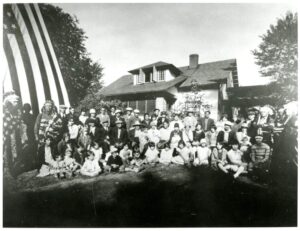The college was built on land that is soaked in the blood of the people from whom it was stolen.
In 1833, the Treaty of Chicago mandated the removal of the Potawatomi tribe from the Great Lakes area, including the land MCCC was built upon, according to the Pokégnek Bodéwadmik website.

After Michigan became a state in 1837, the Potawatomi tribe was forced to move west, a journey that killed an estimated 50 of the 500 Potawatomi people involved, the website states.
Small groups of Potawatomi families fled to Canada and northern Michigan. The United States government found those families and relocated them at gunpoint to reservations in western Michigan, according to the website.
With the goal of acknowledging these events, MCCC is in the process of creating a land acknowledgement document. It is a commitment to honoring the Indigenous people who were removed or killed, as well as surviving Indigenous people and their relationships with the land, states the draft.
“Invisibility is Indigenous peoples’ biggest problem,” said Julie Dye, Bodéwadmik Potawatomi tribe elder. “It is the reason for everything we have endured.”
To demonstrate this commitment, the current draft states several actionable points that MCCC will make. For example, the document states, “MCCC, in solidarity with all twelve federally recognized nations in Michigan, supports the removal of the Custer monument.”
The document was presented before the Faculty Council on Sept. 21. The council unanimously voted to voice support.

However, this is not the final version of the draft. MCCC President Kojo Quartey stated that the final version of the draft will not have MCCC take any definitive stance on the Custer monument.
“That particular issue is a political lightning rod,” said Quartey. “Why would we want to be involved in such a controversy knowing that we are supported by an entire county with differing opinions?”
Quartey said that because MCCC is an educational institution, it would not be appropriate for the school to be involved so directly in such a political matter.
Additionally, Quartey stated that he plans to soften the language used in the document and to get rid of any statements that demonize any groups of people.
“We support the native tribes. We understand that there was genocide that occurred,” Quartey said. “We want to bring about reconciliation and healing, and creating any more controversial issues is not the way to do that.”
Monroe community member and Cheyenne and Arapaho tribe member Graham Denton disagreed with the decision for MCCC to withdraw its support for removing the Custer statue.
“I understand his position, but it was disappointing to hear it,” Denton said. “I wish people would step up in actually acknowledging the truth. They’ve privately told me they agree- then publicly, they should say it.”
Denton said actually taking action is key to making the land acknowledgment meaningful. He said he worries that because it has to be filtered through an educational institution, it will lose the language that would inspire people to act.
“We’re kind of sitting here waiting,” Denton said. “Will it just be words, or are you willing to actually support Indigenous people in current issues?”
Both Denton and Dye emphasized the importance of educating people about the full history behind what Custer did.
“We need to scrub the sugar coating that is on American history. We are American history,” said Dye. “It has to be plain talk. Real talk. We can’t gloss over the atrocities he committed.’
Edmund La Clair, assistant professor of history and contributor to the land acknowledgment, said the statue should be moved elsewhere and used as a history lesson with signage that provides more context.
“I challenge you to come, sit down and learn this history you’re defending,” La Clair said.
Quartey said he did not anticipate the land acknowledgment to grow in the way it has.
The initial project was to simply create a statement to read out loud before each MCCC event.
This was inspired by Melissa Grey, professor of psychology and contributor to the land acknowledgment, who created a short land acknowledgement statement to read before each Coalition for Racial Equality, Equity and Diversity meeting.
Grey said she was inspired by hearing land acknowledgments at other colleges’ events.
Quartey then gave Grey and Barbara Mauter, faculty specialist, the responsibility of developing a campus-wide land acknowledgment.
Mauter and Grey began the process of creating the document in January 2021.
“Without some acknowledgement of our past, we really can’t authentically connect with each other if we don’t have an understanding of how we came to be who we are,” said Grey.
As the project grew, so did the team working on it. Currently, there are 15 people who have contributed, including Mauter and Grey.
That number will only grow as they request more people’s perspectives on the matter.
Dye said that the process to create the document has involved a lot of work, discussion and explanation.
“I’m really satisfied with it,” Dye said. “I hope the language stays even if the Custer statue gets thrown out. It will be a great learning opportunity for a lot of people.”
Before each MCCC event, someone will read a shortened version of the land acknowledgment, Quartey said.
“It shifts our mindsets to a very different orientation by stating that we are in a place where we are benefitting from violence against others and ongoing theft,” Grey said.
La Clair projects that the document will be complete by November, but it is still under development.
“More than anything, I hope this leads to more education,” Denton said. “If you just introduce people more and more to our culture, and we become less and less strangers, you’re way less likely to annihilate each other.”

